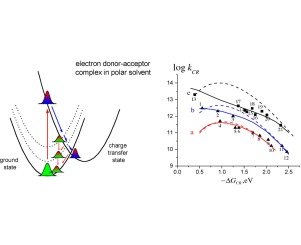Journal of Photochemistry and Photobiology C: Photochemistry Reviews ( IF 12.8 ) Pub Date : 2016-11-22 , DOI: 10.1016/j.jphotochemrev.2016.11.001 Serguei V. Feskov , Valentina A. Mikhailova , Anatoly I. Ivanov

|
Modern laser-based spectroscopy has provided methods for detection ultrafast photochemical transformations occurring on the timescale of intramolecular and solvent reorganization. Such processes usually proceed in non-equilibrium regime, in parallel with nuclear relaxation, and often manifest strong deviations from the Kasha–Vavilov rule. In particular, they offer a possibility to control the yield of photoinduced electron transfer (ET) by using different excitation wavelengths. In the last decade the non-equilibrium charge transfer (CT) processes have attracted considerable interest from the scientific community due to their determining role in photosynthesis, dye-sensitized solar cells and various molecular electronic devices. Non-equilibrium of nuclear (intramolecular and solvent) degrees of freedom can be created by a pump pulse or by photoreaction itself at some of its stages. In this review both situations are considered and illustrated by examples in which non-equilibrium effects are pronounced. It is shown that ultrafast charge recombination in photoexcited donor–acceptor complexes and photochemical processes in donor–acceptor1–acceptor2 molecular compounds proceed predominantly in non-equilibrium (hot) regime. It is important that kinetics and product yields of these reactions demonstrate regularities that considerably differ from that observed in thermal reactions. Among them, the lack of the Marcus normal region in the free energy gap law for charge recombination of the excited donor–acceptor complexes, extremely low quantum yields of the thermalized charge separated states in ultrafast CT from the second excited state of the donor are most known. Although there have been many efforts to clarify microscopic mechanisms of non-equilibrium photoreactions by using ultrafast time-resolved spectroscopy techniques, control of the rate and efficiency of photoinduced charge transfer reactions is still an open challenge. One of the most important applications here is a suppression of ultrafast charge recombination in CT systems, formed either by direct optical excitation or by the preceding ET step. In these systems charge recombination is often regarded as undesirable process, leading to the loss of energy and selectivity of photoreaction. In this review some strategies of ultrafast charge recombination suppression are discussed. The non-equilibrium effects are interpreted from a unified point of view in context of the multichannel point-transition stochastic model. This approach demonstrates similarities and differences in ET mechanisms in various donor–acceptor molecular systems and allows formulating general regularities inherent to these phenomena. We believe that new advances in this research area will not only help to discover new fundamental information about these regularities, but will also have impact on many emerging technologies where ultrafast CT plays the central role.
中文翻译:

超快光诱导电荷转移动力学中的非平衡效应
现代基于激光的光谱学提供了检测在分子内和溶剂重组的时间尺度上发生的超快速光化学转变的方法。这样的过程通常与核弛豫同时在非平衡状态下进行,并且经常表现出与卡沙-瓦维洛夫规则的强烈背离。特别是,它们提供了通过使用不同的激发波长来控制光诱导电子转移(ET)产量的可能性。在过去的十年中,由于非平衡电荷转移(CT)过程在光合作用,染料敏化太阳能电池和各种分子电子设备中的决定性作用,引起了科学界的极大兴趣。核(分子内和溶剂)自由度的非平衡可能是由泵浦脉冲或在某些阶段的光反应本身造成的。在这篇综述中,两种情况都通过非平衡效应明显的例子加以考虑和说明。结果表明,光激发的供体-受体复合物中的超快电荷重组和供体-受体中的光化学过程1 –接受器2分子化合物主要在非平衡(热)状态下进行。重要的是,这些反应的动力学和产物收率应显示出与热反应中观察到的规律性显着不同的规律性。其中,在自由能隙定律中缺少激发供体-受体复合物的电荷重组的Marcus正常区域,超快CT中从供体的第二个激发态的热电荷分离态的量子产率极低。众所周知。尽管已经进行了许多努力来通过使用超快时间分辨光谱技术来阐明非平衡光反应的微观机理,但是控制光诱导的电荷转移反应的速率和效率仍然是一个开放的挑战。这里最重要的应用之一是抑制CT系统中的超快速电荷复合,这种复合是通过直接光激发或通过先前的ET步骤形成的。在这些系统中,电荷重组通常被认为是不合需要的过程,从而导致能量损失和光反应选择性。在这篇综述中,讨论了抑制超快速电荷重组的一些策略。在多通道点转换随机模型的上下文中,从统一的角度解释了非平衡效应。这种方法证明了在各种供体-受体分子系统中ET机制的相似性和差异性,并允许制定这些现象固有的一般规律。











































 京公网安备 11010802027423号
京公网安备 11010802027423号